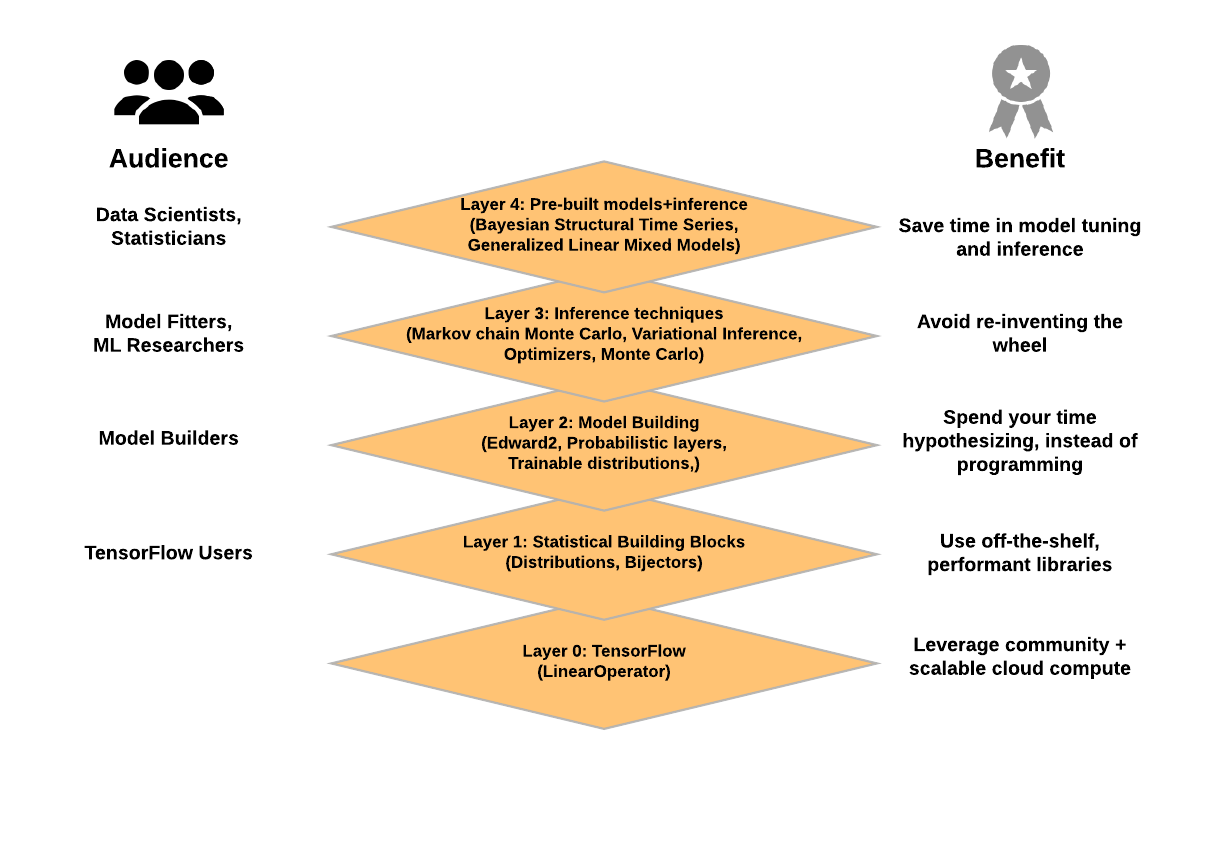A Dockerfile that will produce a container with all the dependencies necessary to run this notebook is available here.
%matplotlib inline
import datetime
import logging
from warnings import filterwarnings
from matplotlib import pyplot as plt
from matplotlib.ticker import StrMethodFormatter
import numpy as np
import pandas as pd
import scipy as sp
import seaborn as sns
from sklearn.preprocessing import LabelEncoder
from theano import pprint
sns.set(color_codes=True)
pct_formatter = StrMethodFormatter('{x:.1%}')
# configure pyplot for readability when rendered as a slideshow and projected
FIG_WIDTH, FIG_HEIGHT = 8, 6
plt.rc('figure', figsize=(FIG_WIDTH, FIG_HEIGHT))
LABELSIZE = 14
plt.rc('axes', labelsize=LABELSIZE)
plt.rc('axes', titlesize=LABELSIZE)
plt.rc('figure', titlesize=LABELSIZE)
plt.rc('legend', fontsize=LABELSIZE)
plt.rc('xtick', labelsize=LABELSIZE)
plt.rc('ytick', labelsize=LABELSIZE)
filterwarnings('ignore', 'findfont')
filterwarnings('ignore', "Conversion of the second argument of issubdtype")
filterwarnings('ignore', "Set changed size during iteration")
# keep theano from complaining about compile locks for small models
(logging.getLogger('theano.gof.compilelock')
.setLevel(logging.CRITICAL))
SEED = 54902 # from random.org, for reproducibility
np.random.seed(SEED)
The HMC Revolution is Open Source¶
Probabilistic Programming with PyMC3¶

@AustinRochford • Tom Tom AMLC • Charlottesville • 4/11/19¶
Who am I?¶

PyMC3 developer • Chief Data Scientist @ Monetate¶
@AustinRochford • Website • GitHub¶
arochford@monetate.com • austin.rochford@gmail.com¶
About Monetate¶

- Founded 2008, web optimization and personalization SaaS
- Observed 5B impressions and $4.1B in revenue during Cyber Week 2017
Modern Bayesian Inference¶

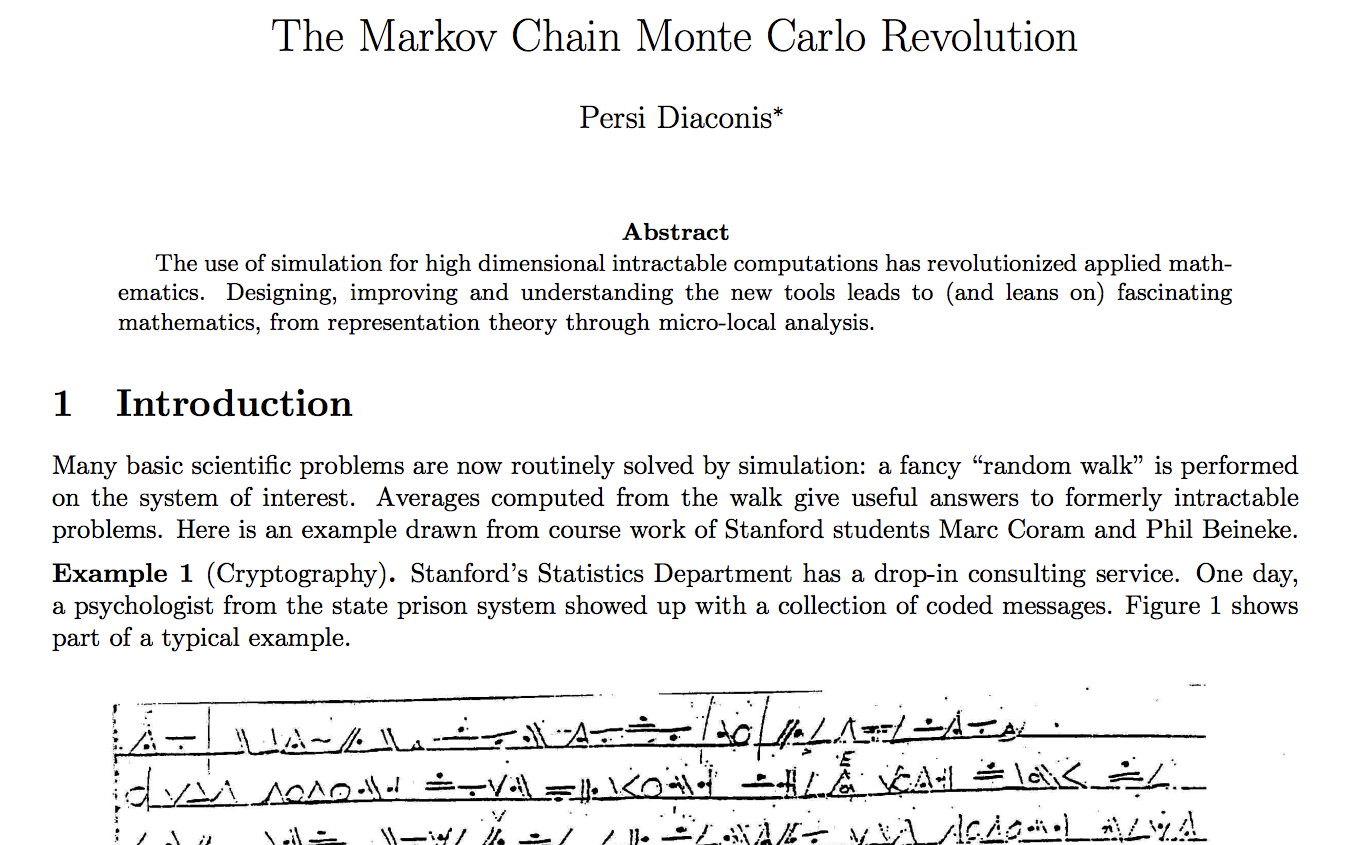
The Markov Chain Monte Carlo Revolution by famous probabilist Persi Diaconis gives an excellent overview of applications of simulation to many quantitative problems.
YouGov, a polling and opinion data company, correctly called a hung parilment as a result of the 2017 UK general elections in the UK using a Bayesian opinion modeling technique knowns as multilevel regression with poststratification (MRP) to produce accurate estimates of voter preferences in the UK's 650 parliamentary constituences.

I have done some work using Bayesian methods to study whether or not committing/drawing fouls is a measurable skill among NBA players.
Player skills(?)¶
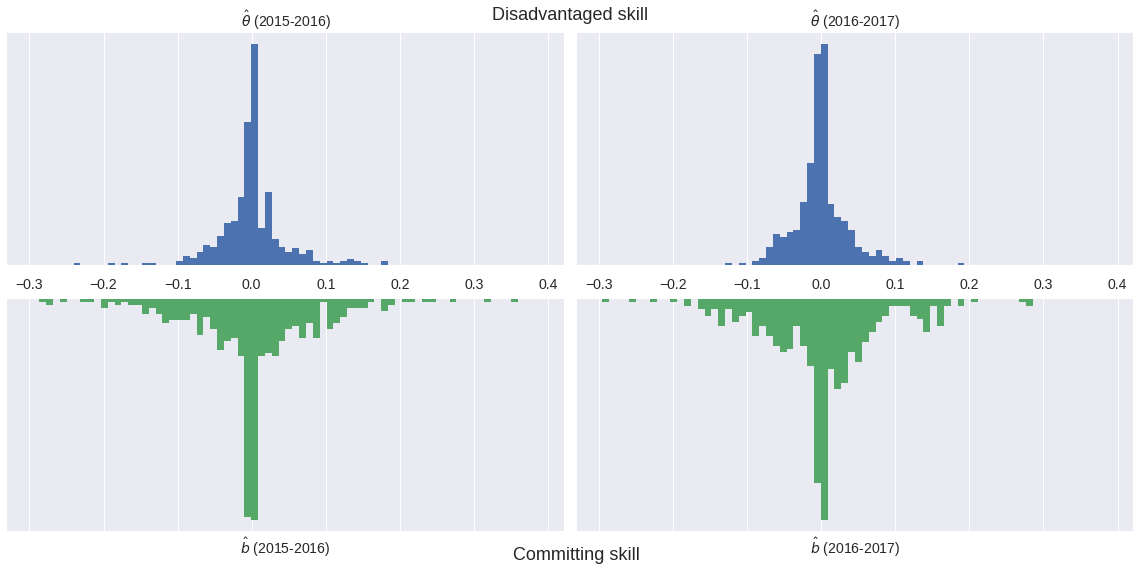
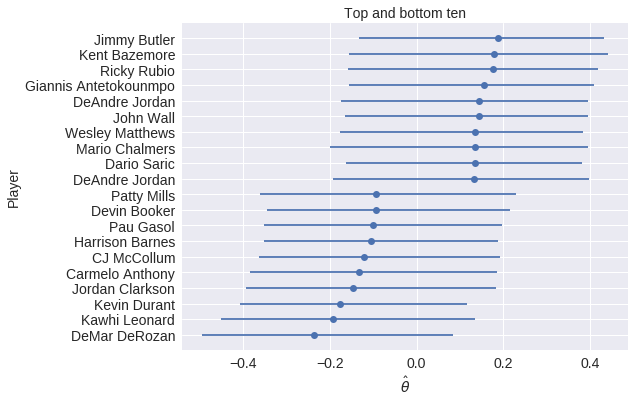 |
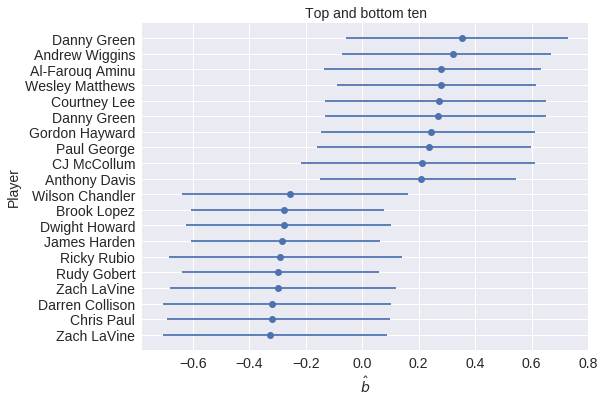 |
Probabilistic Programming — storytelling enables inference¶

The Monty Hall Problem¶

Initially, we have no information about which door the prize is behind.
import pymc3 as pm
with pm.Model() as monty_model:
prize = pm.DiscreteUniform('prize', 0, 2)
If we choose door one:
| Prize behind | Door 1 | Door 2 | Door 3 |
|---|---|---|---|
| Door 1 | No | Yes | Yes |
| Door 2 | No | No | Yes |
| Door 3 | No | Yes | No |
from theano import tensor as tt
with monty_model:
p_open = pm.Deterministic(
'p_open',
tt.switch(tt.eq(prize, 0),
np.array([0., 0.5, 0.5]), # it is behind the first door
tt.switch(tt.eq(prize, 1),
np.array([0., 0., 1.]), # it is behind the second door
np.array([0., 1., 0.]))) # it is behind the third door
)
Monty opened the third door, revealing a goat.

with monty_model:
opened = pm.Categorical('opened', p_open, observed=2)
Should we switch our choice of door?
CHAINS = 3
SAMPLE_KWARGS = {
'chains': CHAINS,
'cores': CHAINS,
'random_seed': list(SEED + np.arange(CHAINS))
}
MONTY_SAMPLE_KWARGS = {
'init': None,
'compute_convergence_checks': False,
**SAMPLE_KWARGS
}
with monty_model:
monty_trace = pm.sample(1000, **MONTY_SAMPLE_KWARGS)
monty_df = pm.trace_to_dataframe(monty_trace)
Multiprocess sampling (3 chains in 3 jobs) Metropolis: [prize] Sampling 3 chains: 100%|██████████| 4500/4500 [00:01<00:00, 4173.25draws/s]
monty_df['prize'].head()
0 0 1 0 2 0 3 0 4 1 Name: prize, dtype: int64
ax = (monty_df['prize']
.value_counts(normalize=True, ascending=True)
.plot(kind='bar', color='C0'))
ax.set_xlabel("Door");
ax.yaxis.set_major_formatter(pct_formatter);
ax.set_ylabel("Probability of prize");

From the PyMC3 documentation:
PyMC3 is a Python package for Bayesian statistical modeling and Probabilistic Machine Learning which focuses on advanced Markov chain Monte Carlo and variational fitting algorithms. Its flexibility and extensibility make it applicable to a large suite of problems.
Case Study: NBA Foul Calls¶

Question: Is (not) committing and/or drawing fouls a measurable player skill?
%%bash
DATA_URI=https://raw.githubusercontent.com/polygraph-cool/last-two-minute-report/32f1c43dfa06c2e7652cc51ea65758007f2a1a01/output/all_games.csv
DATA_DEST=/tmp/all_games.csv
if [[ ! -e $DATA_DEST ]];
then
wget -q -O $DATA_DEST $DATA_URI
fi
USECOLS = [
'period',
'seconds_left',
'call_type',
'committing_player',
'disadvantaged_player',
'review_decision',
'play_id',
'away',
'home',
'date',
'score_away',
'score_home',
'disadvantaged_team',
'committing_team'
]
orig_df = pd.read_csv(
'/tmp/all_games.csv',
usecols=USECOLS,
index_col='play_id',
parse_dates=['date']
)
orig_df.head(n=2).T
| play_id | 20150301CLEHOU-0 | 20150301CLEHOU-1 |
|---|---|---|
| period | Q4 | Q4 |
| seconds_left | 112 | 103 |
| call_type | Foul: Shooting | Foul: Shooting |
| committing_player | Josh Smith | J.R. Smith |
| disadvantaged_player | Kevin Love | James Harden |
| review_decision | CNC | CC |
| away | CLE | CLE |
| home | HOU | HOU |
| date | 2015-03-01 00:00:00 | 2015-03-01 00:00:00 |
| score_away | 103 | 103 |
| score_home | 105 | 105 |
| disadvantaged_team | CLE | HOU |
| committing_team | HOU | CLE |
foul_df = orig_df[
orig_df.call_type
.fillna("UNKNOWN")
.str.startswith("Foul")
]
FOULS = [
f"Foul: {foul_type}"
for foul_type in [
"Personal",
"Shooting",
"Offensive",
"Loose Ball",
"Away from Play"
]
]
TEAM_MAP = {
"NKY": "NYK",
"COS": "BOS",
"SAT": "SAS",
"CHi": "CHI",
"LA)": "LAC",
"AT)": "ATL",
"ARL": "ATL"
}
def correct_team_name(col):
def _correct_team_name(df):
return df[col].apply(lambda team_name: TEAM_MAP.get(team_name, team_name))
return _correct_team_name
def date_to_season(date):
if date >= datetime.datetime(2017, 10, 17):
return '2017-2018'
elif date >= datetime.datetime(2016, 10, 25):
return '2016-2017'
elif date >= datetime.datetime(2015, 10, 27):
return '2015-2016'
else:
return '2014-2015'
clean_df = (foul_df.where(lambda df: df.period == "Q4")
.where(lambda df: (df.date.between(datetime.datetime(2016, 10, 25),
datetime.datetime(2017, 4, 12))
| df.date.between(datetime.datetime(2015, 10, 27),
datetime.datetime(2016, 5, 30)))
)
.assign(
review_decision=lambda df: df.review_decision.fillna("INC"),
committing_team=correct_team_name('committing_team'),
disadvantged_team=correct_team_name('disadvantaged_team'),
away=correct_team_name('away'),
home=correct_team_name('home'),
season=lambda df: df.date.apply(date_to_season)
)
.where(lambda df: df.call_type.isin(FOULS))
.dropna()
.drop('period', axis=1)
.assign(call_type=lambda df: (df.call_type
.str.split(': ', expand=True)
.iloc[:, 1])))
player_enc = LabelEncoder().fit(
np.concatenate((
clean_df.committing_player,
clean_df.disadvantaged_player
))
)
n_player = player_enc.classes_.size
season_enc = LabelEncoder().fit(
clean_df.season
)
n_season = season_enc.classes_.size
df = (clean_df[['seconds_left']]
.round(0)
.assign(
foul_called=1. * clean_df.review_decision.isin(['CC', 'INC']),
player_committing=player_enc.transform(clean_df.committing_player),
player_disadvantaged=player_enc.transform(clean_df.disadvantaged_player),
score_committing=clean_df.score_home.where(
clean_df.committing_team == clean_df.home,
clean_df.score_away
),
score_disadvantaged=clean_df.score_home.where(
clean_df.disadvantaged_team == clean_df.home,
clean_df.score_away
),
season=season_enc.transform(clean_df.season)
))
player_committing = df.player_committing.values
player_disadvantaged = df.player_disadvantaged.values
season = df.season.values
def hierarchical_normal(name, shape):
Δ = pm.Normal(f'Δ_{name}', 0., 1., shape=shape)
σ = pm.HalfNormal(f'σ_{name}', 5.)
return pm.Deterministic(name, Δ * σ)
with pm.Model() as irt_model:
β_season = pm.Normal('β_season', 0., 2.5, shape=n_season)
θ = hierarchical_normal('θ', n_player) # disadvantaged skill
b = hierarchical_normal('b', n_player) # committing skill
p = pm.math.sigmoid(
β_season[season] + θ[player_disadvantaged] - b[player_committing]
)
obs = pm.Bernoulli(
'obs', p,
observed=df['foul_called'].values
)
Metropolis-Hastings Inference¶
with irt_model:
step = pm.Metropolis()
met_trace = pm.sample(5000, step=step, **SAMPLE_KWARGS)
Multiprocess sampling (3 chains in 3 jobs) CompoundStep >Metropolis: [σ_b] >Metropolis: [Δ_b] >Metropolis: [σ_θ] >Metropolis: [Δ_θ] >Metropolis: [β_season] Sampling 3 chains: 100%|██████████| 16500/16500 [01:48<00:00, 152.44draws/s] The gelman-rubin statistic is larger than 1.4 for some parameters. The sampler did not converge. The estimated number of effective samples is smaller than 200 for some parameters.

met_gr_stats = pm.gelman_rubin(met_trace)
met_θ_worst_ix = met_gr_stats['θ'].argmax()
met_θ_worst = np.concatenate([
chain_values[np.newaxis, :, met_θ_worst_ix]
for chain_values in met_trace.get_values('θ', combine=False)
])
trace_fig, (trace_ax, hist_ax) = plt.subplots(ncols=2, figsize=(16, 6))
trace_ax.plot(met_θ_worst.T, alpha=0.5);
trace_ax.set_xticklabels([]);
trace_ax.set_xlabel("Sample index");
worst_param_label = r"$\theta_{" + str(met_θ_worst_ix) + "}$"
trace_ax.set_ylabel(worst_param_label);
sns.distplot(
met_trace['θ'][:, met_θ_worst_ix],
kde=False, norm_hist=True, ax=hist_ax
);
hist_ax.set_xlabel(worst_param_label);
hist_ax.set_yticks([]);
hist_ax.set_ylabel("Posterior density");
trace_fig.suptitle("Metropolis-Hastings");
/opt/conda/lib/python3.6/site-packages/matplotlib/axes/_axes.py:6521: MatplotlibDeprecationWarning: The 'normed' kwarg was deprecated in Matplotlib 2.1 and will be removed in 3.1. Use 'density' instead. alternative="'density'", removal="3.1")
trace_fig
max(np.max(var_stats) for var_stats in pm.gelman_rubin(met_trace).values())
3.1038666861280597
The Curse of Dimensionality¶
This model has
n_param = n_season + 2 * n_player
n_param
948
parameters
The curse of dimensionality is a well-known concept in machine learning. It refers to the fact that as the number of dimensions in the sample space increases, samples become (on average) far apart quite quickly. It is related to the more complicated phenomenon of concentration of measure, which is the actual motivation for Hamiltonian Monte Carlo (HMC) algorithms.
The following plot illustrates one of the one aspect of the curse of dimensionality, that the volume of the unit ball tends to zero as the dimensionality of the space becomes large. That is, if
Sd={→x∈Rd | x21+⋯+x2d≤1},Vol(Sd)=2πd2d Γ(d2).And we get that Vol(Sd)→0 as d→∞.
def sphere_volume(d):
return 2. * np.power(np.pi, d / 2.) / d / sp.special.gamma(d / 2)
fig, ax = plt.subplots()
d_plot = np.linspace(1, n_param)
ax.plot(d_plot, sphere_volume(d_plot));
ax.set_xscale('log');
ax.set_xlabel("Dimensions");
ax.set_yscale('log');
ax.set_ylabel("Volume of the unit sphere");
fig
Case Study Continued: NBA Foul Calls¶
with irt_model:
nuts_trace = pm.sample(500, **SAMPLE_KWARGS)
Auto-assigning NUTS sampler... Initializing NUTS using jitter+adapt_diag... Multiprocess sampling (3 chains in 3 jobs) NUTS: [σ_b, Δ_b, σ_θ, Δ_θ, β_season] Sampling 3 chains: 100%|██████████| 3000/3000 [02:14<00:00, 22.23draws/s]
nuts_gr_stats = pm.gelman_rubin(nuts_trace)
max(np.max(var_stats) for var_stats in nuts_gr_stats.values())
1.0069298341016355
nuts_θ_worst = np.concatenate([
chain_values[np.newaxis, :, met_gr_stats['θ'].argmax()]
for chain_values in nuts_trace.get_values('θ', combine=False)
])
fig, (met_axs, nuts_axs) = plt.subplots(nrows=2, ncols=2, figsize=(16, 12))
(met_trace_ax, met_hist_ax) = met_axs
met_trace_ax.plot(met_θ_worst.T, alpha=0.5);
worst_param_label = r"$\theta_{" + str(met_θ_worst_ix) + "}$"
met_trace_ax.set_ylabel("Metropolis-Hastings\n" + worst_param_label);
sns.distplot(
met_trace['θ'][:, met_θ_worst_ix],
kde=False, norm_hist=True, ax=met_hist_ax
);
XMIN = min(met_trace['θ'][:, met_θ_worst_ix].min(),
nuts_trace['θ'][:, met_θ_worst_ix].min())
XMAX = min(met_trace['θ'][:, met_θ_worst_ix].max(),
nuts_trace['θ'][:, met_θ_worst_ix].max())
met_hist_ax.set_xlim(XMIN, XMAX);
met_hist_ax.set_yticks([]);
met_hist_ax.set_ylabel("Posterior density");
(nuts_trace_ax, nuts_hist_ax) = nuts_axs
nuts_trace_ax.plot(nuts_θ_worst.T, alpha=0.5);
nuts_trace_ax.set_xlabel("Sample index");
nuts_trace_ax.set_ylabel("HMC\n" + worst_param_label);
sns.distplot(
nuts_trace['θ'][:, met_θ_worst_ix],
kde=False, norm_hist=True, ax=nuts_hist_ax
);
nuts_hist_ax.set_xlim(XMIN, XMAX);
nuts_hist_ax.set_xlabel(worst_param_label);
nuts_hist_ax.set_yticks([]);
nuts_hist_ax.set_ylabel("Posterior density");
fig.tight_layout();
/opt/conda/lib/python3.6/site-packages/matplotlib/axes/_axes.py:6521: MatplotlibDeprecationWarning: The 'normed' kwarg was deprecated in Matplotlib 2.1 and will be removed in 3.1. Use 'density' instead. alternative="'density'", removal="3.1")
fig
Basketball strategy leads to more complexity¶

df['trailing_committing'] = (df.score_committing
.lt(df.score_disadvantaged)
.mul(1.)
.astype(np.int64))
def make_foul_rate_yaxis(ax, label="Observed foul call rate"):
ax.yaxis.set_major_formatter(pct_formatter)
ax.set_ylabel(label)
return ax
def make_time_axes(ax,
xlabel="Seconds remaining in game",
ylabel="Observed foul call rate"):
ax.invert_xaxis()
ax.set_xlabel(xlabel)
return make_foul_rate_yaxis(ax, label=ylabel)
fig = make_time_axes(
df.pivot_table('foul_called', 'seconds_left', 'trailing_committing')
.rolling(20).mean()
.rename(columns={0: "No", 1: "Yes"})
.rename_axis("Committing team is trailing", axis=1)
.plot()
).figure
fig
Next Steps with Probabilistic Programming¶
The following books/GitHub repositories provide good introductions to PyMC3 and Bayesian statistics.
PyMC3¶
|
|

|

|
Probabilistic Programming Ecosystem¶

Hamiltonian Monte Carlo¶
 A Conceptual Introduction to Hamiltonian Monte Carlo
A Conceptual Introduction to Hamiltonian Monte Carlo
%%bash
jupyter nbconvert \
--to=slides \
--reveal-prefix=https://cdnjs.cloudflare.com/ajax/libs/reveal.js/3.2.0/ \
--output=hmc-oss-amlc-2019 \
./hmc-oss-pymc3-amlc-2019.ipynb
[NbConvertApp] Converting notebook ./hmc-oss-pymc3-amlc-2019.ipynb to slides [NbConvertApp] Writing 709260 bytes to ./hmc-oss-amlc-2019.slides.html









